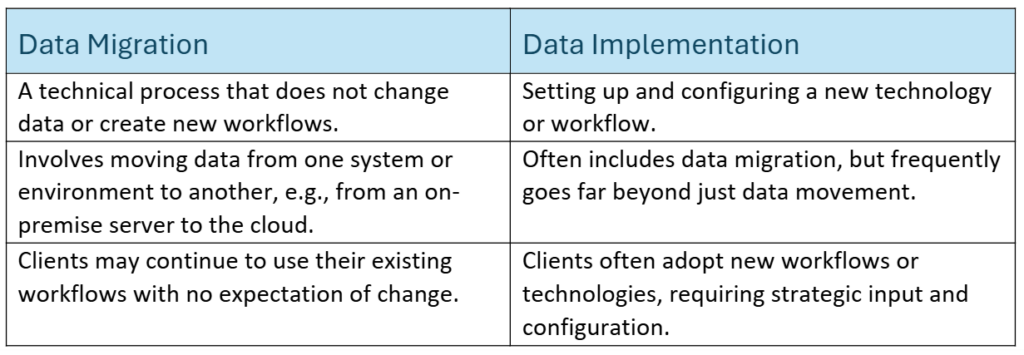Technology implementation is the process of incorporating new technology—software, hardware, or systems—into an organization’s operations to improve workflows, boost efficiency, and achieve business goals. Sounds simple, right? Not so much.
New technology promises many advantages to law firms, corporations, and government entities that take the leap and adopt it: greater efficiency, user friendliness, better service delivery, and a competitive edge. Yet, according to a recent LexisNexis survey, almost half of the lawyers surveyed said their firm or legal team is slow to implement new technology, particularly AI.
The survey also found that legal professionals increasingly worry that this risk-averse nature and subsequent failure to adopt new technology will result in missed opportunities, lost talent, and growing inefficiencies. Over 66 percent of those surveyed said they would be more receptive to using new technologies like AI if they received the proper training and support.
Technology implementation is much more than simply installing a tool. The system must be integrated into workflows and fully adopted to deliver measurable value. Success relies on strategic planning, user engagement, and continuous training and support.
How Does a Technology Implementation Differ From a Data Migration?
Data migration and implementation often go hand in hand, and implementation frequently involves some degree of data migration. However, data migration can happen without full implementation, such as moving from one Relativity environment to another without changing the way a team operates. Here are some additional distinctions:

A smooth data migration is critical to maintain data integrity, minimize downtime, and ensure business continuity. However, those responsible for implementation often face challenges that can threaten the success of both the migration and the overall initiative.
Challenges to a Seamless Technology Implementation
Whether working with a law firm, corporation, or government agency, implementing new technology can present significant challenges:
- Extended delays: Organizations rely on critical systems to meet deadlines and deliver results. Any lengthy delay in implementation can lead to productivity loss or reputational risk.
- Inadequate training: Users require hands-on, role-specific training to fully adopt new tools and identify workflow improvements.
- Integration issues: The new solution may not integrate well with existing platforms or data sources. Transferring data between old and new systems can introduce errors or inefficiencies.
- Poor planning: If the goals of the implementation aren’t clearly defined, the solution may not solve the actual business problem. Scope changes can lead to delays and added costs.
- Resistance to change: Teams often resist moving away from familiar tools or processes. Concerns may arise around job security, learning curves, or perceived complexity.
Avoiding these pitfalls requires strong collaboration between the client and technology partner, a clear change management strategy, and user-centric rollout planning.
Steps to Ensure a Successful Technology Implementation
Implementations vary in complexity depending on the organization’s needs, existing systems, and tolerance for change. Some best practices include:
- Pre-implementation planning: Define objectives, identify stakeholders, and establish a clear scope, timeline, and budget.
- Align people, process, and technology: Gain executive buy-in and communicate how the new solution aligns with strategic goals. Foster user ownership and engagement.
- Clarify objectives: Temper expectations around new technologies by identifying who will be impacted, how they’ll benefit, and what success looks like.
- Develop communication strategies: Use multiple channels—meetings, emails, newsletters—to keep teams informed and engaged. Share early wins and success stories.
- Determine rollout strategy: Choose between a phased rollout (by department, region, or function) or a “big bang” approach, depending on complexity and readiness.
- Provide ongoing training: Tailor training to various user roles and update it as needed. Use sandbox environments to help users gain confidence in a safe, simulated space.
- Set and adjust metrics: Define KPIs early and refine them as the implementation progresses.
- Plan for long-term support: Establish technical support and governance strategies for post-launch needs, including maintenance, updates, and enhancements.
Real-World Impact: Exterro Implementation at a Global Organization
Technology implementations are not one-size-fits-all. At CDS, we’ve worked with both law firms and corporate legal departments to design and execute meaningful solutions. For example, CDS supported a global organization in implementing Exterro, enabling the team to drastically reduce the time required to collect data across multiple sources—like M365, iManage, and OneDrive—for employee departures or case transitions.
What once took two months in a manual, error-prone process was reduced to less than 24 hours using a customized workflow built on the Exterro platform. This transformation highlights how the right combination of technology and thoughtful planning can significantly improve operational efficiency, even in complex environments.
In some cases, our engagements don’t involve introducing new platforms at all. CDS also develops and implements custom workflows within clients’ existing systems, delivering real impact without requiring new tools.
How CDS Can Help
Even seemingly basic data migrations or tech deployments can uncover hidden complexities. CDS brings expertise in streamlining legal and corporate workflows, reducing risk, and ensuring long-term success. Whether implementing a new platform or optimizing your current environment, we help organizations design tailored solutions that work.
To learn more about how CDS can support your technology implementation, contact us at to schedule a consultation.



